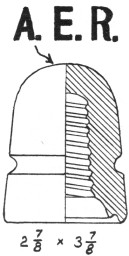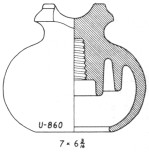Porcelain Insulator News
by Jack H. Tod, NIA #13
Reprinted from "INSULATORS - Crown Jewels of the Wire", December 1980, page 29
I found a really beautiful baby beehive with an unusual
marking, and I'm wondering if you've heard of it before. It's similar to the
glass CD-143's, quite like the ordinary C.P.R. and C.N.R. porcelain beehives we
see (sketch at right). The glaze is a glisteny white, and the "A.E.R."
marking on the crown is underglaze in dull green ink.

I found this on a spur of
the Algoma Central Railway just north of Sault St. Marie, Ontario. It has to be
uncommon, since I checked the entire Algoma system and found no others. This
railway links together many old mining towns, and it has been in operation for
over a century. Sure would like to know who made it and when.
Terry Smith
Port
Huron, Mich.
- - - - - - - - -
Dear Terry:
Certainly one of our readers will be able to attribute
this marking. I've never seen any of this style made by Pittsburg which were of
such nice quality, so maybe this one was made in England. It's tempting to guess
at the name by initial-matching, but every time I try that it just proves how
unlucky I am.
Jack
Dear Jack:
I have a question about two "teat rest"
insulators I have, both U-610 or similar. One with a faint O-B embossing has a
very crude teat rest, as if the crown was formed by hand. In fact, it almost
looks like a cross-top, with one groove machine made and the other hand carved,
with the four teats kind of pushed up from the rest of the insulator. The other
insulator is a no-name, dry-process, very nicely glazed and well made. An
interesting thing about both specimens is they were fired petticoat rest, not on
the teats as perhaps they were designed for. Is the O-B one typical of these?
Any info on the dry process one would be appreciated.
I have a small
suspension insulator with the Rectangle-V marking (incuse) but also with a
number "1959" immediately beneath that. Since Victor Insulators Inc.
was purchased by I-T-E Imperial back in 1953, I'm wondering if the
"1959" is a catalog number and not a year date. Any info?
I just
purchased a U-50 "G" embossed insulator in white! I haven't heard of
this one in white before. By the way, I still need a "G" (any color)
of U-272 and U-55 Similar. Also I've recently added a U-259 Fred M. Locke with
the #0-6 marking struck twice on the crown top. But the best bargain I've gotten
in a long time: A U-529A Fred M. Locke in tan, 1-3/8" pinhole, for $1.50 at
an antique store!
David Bethman
Bellingham, Wash.
- - - - - - - - - -
Dear David:
I think the scheme
of firing wholly-glazed insulators on those little teats and then breaking them
out of the sager or kiln car shelf with a mallet or whatever was a horrible
idea, and I wouldn't doubt that O-B hung the guy who thought of that -- up by his
ears so the sap could run out of his pin hole. Since the majority of these
teat-rest specimens were fired on the petticoat, I think they gave it up pretty
quick. The ones actually fired an the teats usually are a ragged mess on the
crown top. I have no answer on the crudely formed O-B you have -- or on the dry
process one either.
I also have never seen any "G" pin types with
white glaze. All the "G" pin types are sneaky tough to locate, and you
just have to be patient to complete the set.
I think the "1959" number
on your V-I suspension must be a catalog number, but I don't have catalog sheets
on their suspensions. Some companies, notably Findlay and later P.P. Inc., used
blocks of catalog numbers on common insulators which ranged up from 1900 and
could thus be confused with year dates.
Jack

Dear Jack:
Here is the additional
info on the O-B U-860 fogbowls mentioned in my last letter to you.
One small
electric utility has been installing these since the 1960's, especially on a
13,800 volt line that services a small coastal town here. This construction has
entirely replaced an earlier line which was built during the 1920's and which
had all sorts of old multis, Pyrex glass etc. on it. The early line was quite
unreliable in stormy weather because of flashovers due to the salt buildup on
the insulators. Before the line was rebuilt with the fogbowls, a wide assortment
of insulators were in use, representing one-by-one replacements during the many
years. According to the line foreman, the fogbowls have practically eliminated
the former outage problems caused by weather.
We don't see too many of
these fogbowls at shows out here and, other than this particular installation,
I've never seen them elsewhere. I think these are an underestimated porcelain
collectible, but no doubt their large size deters some people from wanting them
as shelf items. I'd imagine they are still being made today by O-B and I-T-E
(Gould, Inc. now), and those in present production probably are with sky glaze.
Do you think that someday the brown ones will be worth more, since they have
been made in sky glaze for over a decade now?
Joe Maurath, Jr.
Abington, Mass.
- - - - - - - - - -
Dear Joe:
Many thanks for this added info, since you had aroused my curiosity.
The various fogbowls and fog-type insulators are standard fare on the west
coast, but we hear so little about their use elsewhere -- maybe just because
people don't write to tell us about them! We not only appreciate your sending to
us news of items seen and found in your eastern area, but I and other collectors
also enjoy all the material in your monthly insulator column in Old Bottle
Magazine.
You may be making some incorrect assumptions regarding the brown glaze
as vs. skyglaze. First, collectors consider both of these glazes current, so
there's nothing very romantic about one as opposed to the other.
Secondly, it is
incorrect that brown glazes are no longer being made. Some utilities use only
brown glaze, others use only sky glaze, and some use both glazes. For instance,
Arizona Public Service uses sky glaze as standard, but they use brown glaze in
the forested mountains so the insulators will blend into the background better.
I don't know how many separate utilities there are now, but there were 3,133
U.S. utilities listed in the 1973 E.W. directory; we had 25 in Arizona.
Certainly many of these electric utilities still use brown glaze as a standard
or for parts of their territory as A.P.S. does here.
I agree with you that there
aren't many fogbowls in collector circles, and especially the older styles.
Fogbowls have never been popularly collected, and I've never been able to deduce
why this is so. As you say, maybe their large size.
Jack
| 